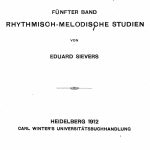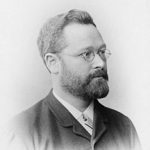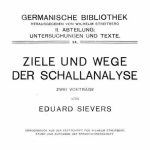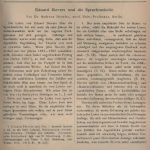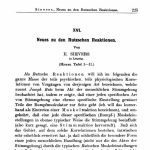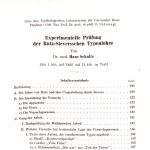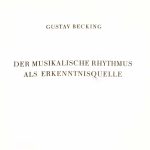Contributor Essays
The Promise of a Philology of the Ear
Eduard Sievers and Sound Analysis
by Reinhart Meyer-Kalkus
March 5, 2018
Around 1900, the Leipzig Germanist Eduard Sievers and his students gave new value to the auditory and phonetic aspects of written documents. With considerable methodological effort and public attention, they issued a rousing call for a “philology of the ear” to replace the “philology of the eye.” Whereas Sievers’s colleagues in historical linguistics limited themselves to the silent reading of written works, now the “sound shape” of texts—their rhythmical, prosodic, and melodic structures—was to become the starting point for a new kind of literary studies, subsequently dubbed “sound analysis” (Schallanalyse).
Eduard Sievers (1850–1932) specialized in phonetics and poetic meter, primarily in older Germanic languages and literatures. In the early 1890s, his studies of rhythm and melodics in poetic language departed from the well-trodden paths of his discipline. He was convinced that particular rhythmical and melodic features were inscribed into the written line as an “objective sound shape” that could be brought back to life through appropriate reading or reciting aloud. Although the spoken line differed from the sung line due to its Gleittöne (“gliding tones” or microtonal transitions), like song every poetic work had a particular sonic form. By this, Sievers meant the specific pitch (high, midrange, or low; constant or varying), interval size (long, medium, or short), modulation (free, legato), and tone-steps (especially at the opening and ending of a line) (“Über Sprachmelodisches in der deutschen Dichtung,” 66). Every literary writer, Sievers argued, was influenced by a “suggestive idea of melody,” which also determined his or her choice of words. As a result, even “a writer working in silence continually produces imagined melodies, even if he is not conscious of this aspect of his production” (“Über ein neues Hilfsmittel philologischer Kritik,” 80–81). The task of both reader and literary researcher was to identify and reproduce the imagined melodies and rhythms that the poet had fixed in writing.
In pursuit of this goal, Sievers suggested conducting “mass studies.” Different test persons would read the same text aloud; if they melodized it in the same way, one could be sure of having achieved a true reflection of the melodic types inserted into the text by its writer (“Über Sprachmelodisches,” 62). For Sievers, investigations of this kind corroborated his claim that each poem has only one correct melody. He distinguished between two types of readers: the “author-reader” and the “self-reader.” Self-readers gave the text their own interpretation and an individual melodization, while author-readers responded to the text instinctively, with the result that many of them produced a similar melodization. Unsurprisingly, Sievers gave preference to the author-reader type in his experiments. The sensorimotor responsiveness of these readers became a springboard for his later speculations on sound analysis.
Sievers also saw recitation as a means of philological textual criticism that enabled conclusions to be drawn about the text’s authorship, revisions by other writers, textual montage, and so on—all issues of the greatest concern to Germanists of the day, who were interested mainly in medieval and older Germanic literatures. Sievers’s plan was to have such texts read aloud repeatedly in order to identify the various voice types and their prosodic and other peculiarities. Methodologically, Sievers followed his own research precept of linking the unity of the text to the unity of the voice. As long as the reading was “uninhibited,” he explained, it was certain that the voice type of the author had been captured. Any inhibition indicated that the text had probably been amended in the course of its history. Sievers’s grand claim, then, was that the genuine vocal character of all authors could be reproduced across all eras, cultures, and historical contexts on the basis of reading aloud. The key to this process was Einfühlung, aesthetic empathy.
Sievers’s Rhythmisch-melodische Studien of 1912 attracted fierce criticism from colleagues such as the metrical specialist Andreas Heusler, who queried the empirical procedure of gathering evidence through mass studies and denied that there could be a single correct way of reading a particular text (“Eduard Sievers und die Sprachmelodie”). However, the negative response from his discipline seems if anything to have emboldened Sievers to reject traditional methods once and for all. The “sound analysis” he proposed in their place was an experimental method to examine the “enforced reactions” imposed by the sound shape of texts—reactions that the motorically inclined reader could not avert. Sievers cited Wilhelm Wundt’s psychological research at the University of Leipzig on the psychophysical origins of involuntary reactions and reflexes. The involuntary motor reactions to a visually perceived text while reading would, Sievers believed, provide the basis for identifying and classifying types of voice and melodization.
Sievers found several allies, such as the Munich lawyer and amateur researcher Ottmar Rutz. Rutz expanded on Sievers’s speculations by defining voice types through the muscular posture of the torso; in 1911, he derived from this a typology of voices and vocal dispositions. Sievers welcomed these (crudely physicalist) speculations as confirming his own approach and integrated them into his sound analysis, as he did the work of Prague musicologist Gustav Becking on the rhythm shapes that supposedly underlay individual composers’ works (known as “Becking curves”). All these elements came together in Sievers’s complex system of sound analysis (“Neues zu den Rutzschen Reaktionen”; Ziele und Wege der Schallanalyse), the categories and procedures of which ultimately remained obscure to all but his most intimate circle. If Sievers’s research on rhythm and melody began as a courageous opening up to neighboring disciplines, such as experimental psychology and phonetics, he later became entangled in “a magical realm of incomprehensible formulae and signs,” as Erich Drach, a sympathetic contemporary, observed in 1930. In the end, he even introduced visual signals, inspired by the spiritualists’ pendulums: metal shapes to which the speaker was to react sensorimotorically in order to find the correct voice and melodization while reading aloud. Sievers added the elaborate use of a conductor’s baton while speaking and other accessories intended to unconsciously affect the speaker’s involuntary reactions, in a methodological patchwork of components from contemporary Wundtian psychophysics, aesthetic empathy theory, physiognomy, and esoteric hocus-pocus. With Wilhelm Doegen, Sievers produced spoken-word phonographic recordings at the Berliner Lautarchiv in the early 1920s in an attempt at popularization, but even these materials do not offer anything that would make the distinctions of voice types and dispositions particularly plausible.
With the bravura of a scientific pioneer, Sievers nevertheless publicly extolled his methods as a resource promising multiple uses, including the identification of criminals through phonographic recordings of their telephone voices or handwritten blackmail notes. As a result, he was occasionally remembered in the 1920s and called up as an expert witness. Notwithstanding these rare public successes, however, the productive bridge between literary studies and linguistics, metrics and phonetics, that Sievers had built with his early studies in rhythm and melody had by now collapsed.
Just a few years after its proclamation, the philology of the ear was discredited in a public controversy when Sievers fell into a trap set by one of his detractors. The theory’s humiliation was probably inevitable, given its overheated claims. Apart from the occasional productive reception (for instance by some Russian formalists), the philology of the ear—or sound analysis, as Sievers called it—was soon banished completely from academic debate, as if in revenge for the exaggerated expectations it had raised.


